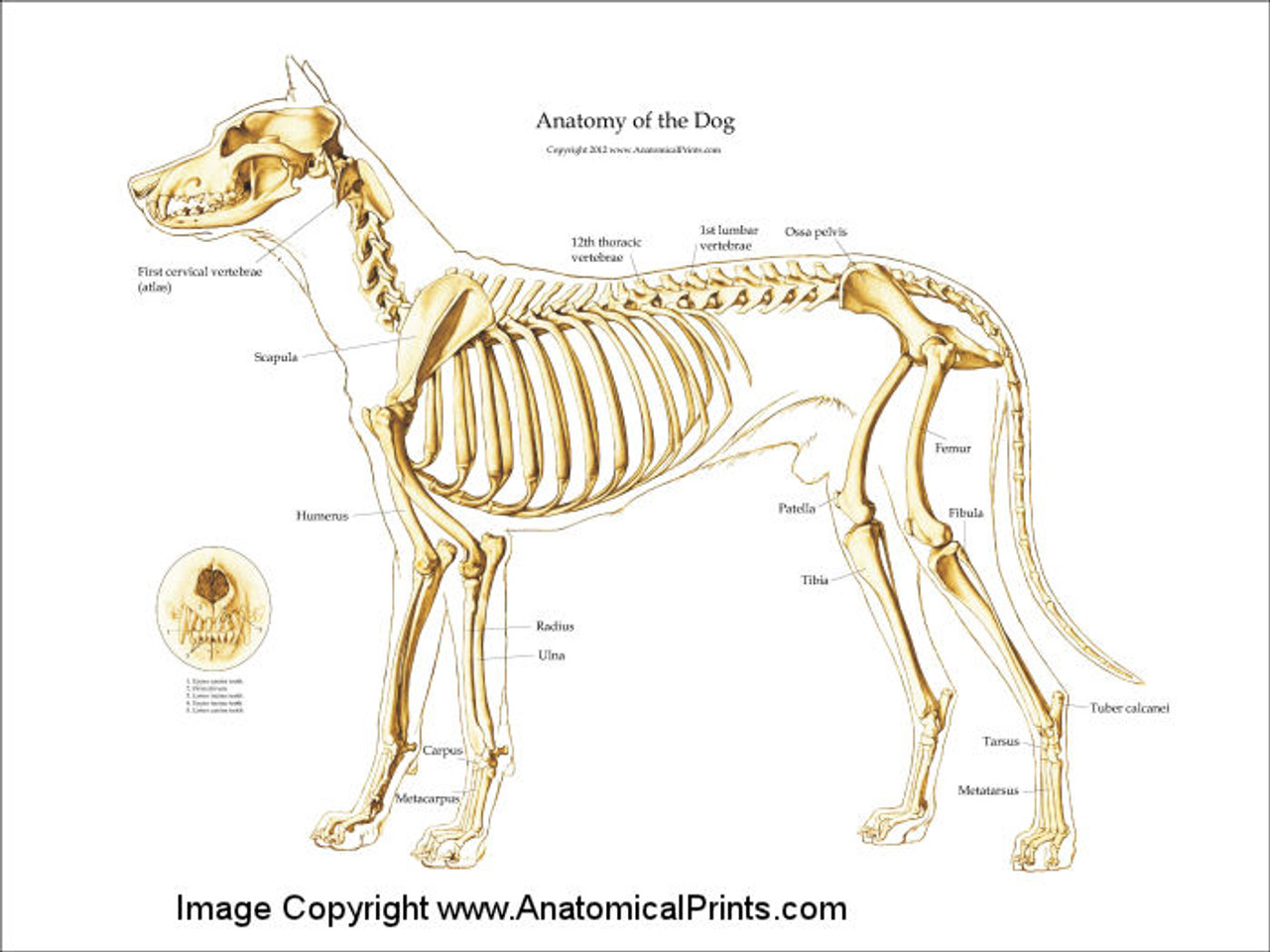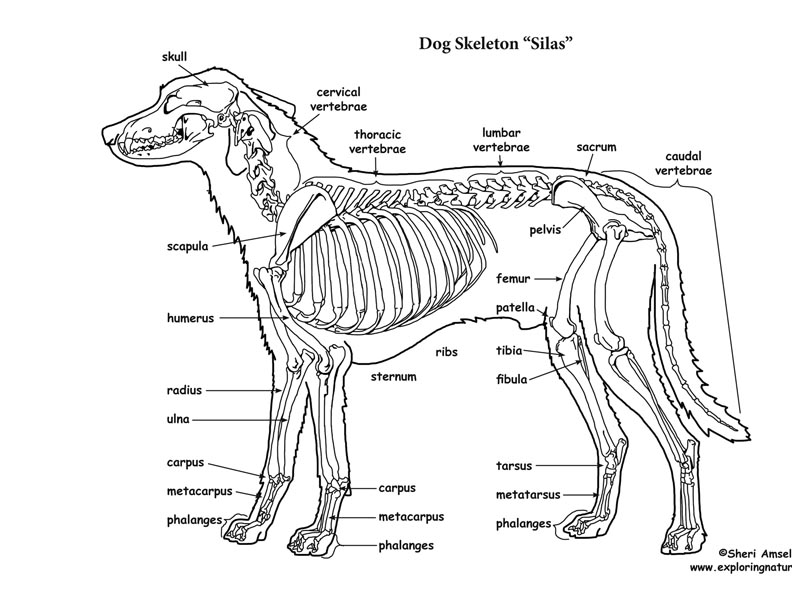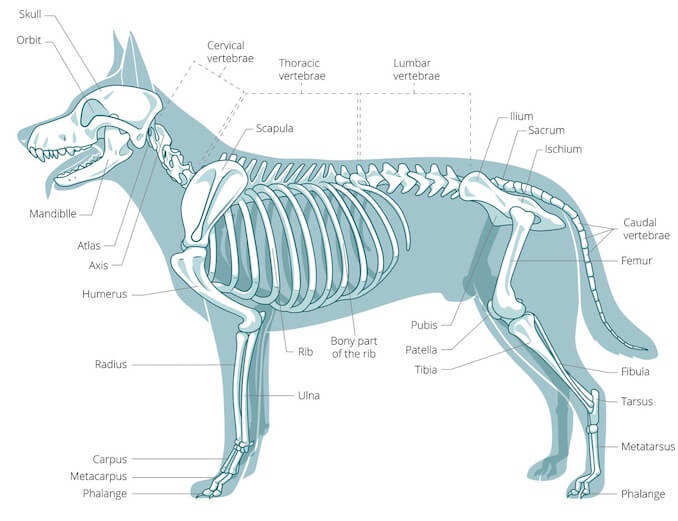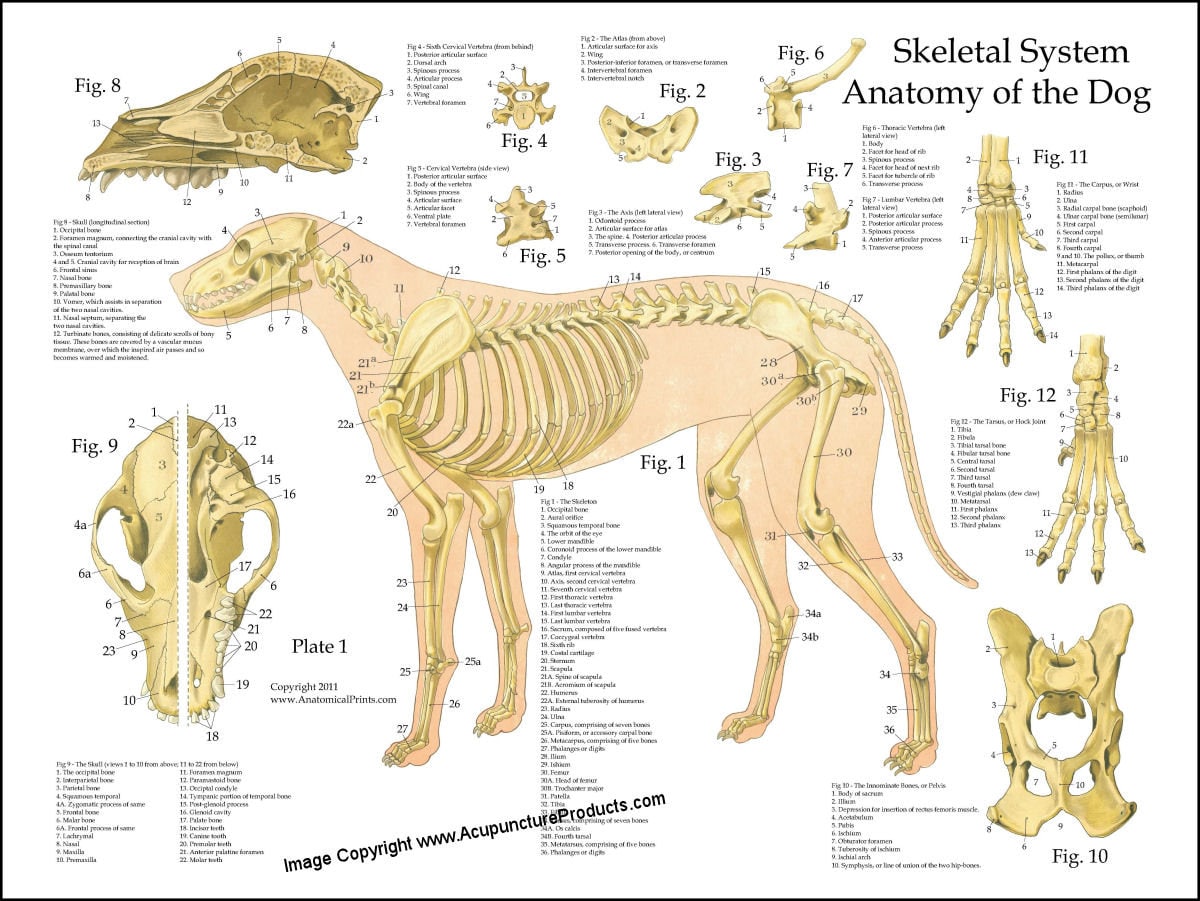
Dog skeleton with major bone elements labeled (Davis, 1987, p. 54;... Download Scientific Diagram
The Anatomage Dog is the first highly detailed dog anatomy atlas that comprehensively features internal organs, including vascular systems and muscular-skeletal structures. Originating from real dog data, the Anatomage Dog exhibits the highest level of anatomical accuracy. All of its volumetric 3D and individual structures are segmented, users.

Canine Skeleton Poster Clinical Charts and Supplies
Dog anatomy comprises the anatomical studies of the visible parts of the body of a domestic dog.Details of structures vary tremendously from breed to breed, more than in any other animal species, wild or domesticated, as dogs are highly variable in height and weight. The smallest known adult dog was a Yorkshire Terrier that stood only 6.3 cm (2.5 in) at the shoulder, 9.5 cm (3.7 in) in length.

Dog Anatomy Dog Skelton
Anatomic Planes. The main planes of motion for dogs are as follows (see Figure 5-1): • The sagittal plane divides the dog into right and left portions. If this plane were in the midline of the body, this is the median plane or median sagittal plane. • The dorsal plane divides the dog into ventral and dorsal portions.

Labeled atlas of anatomy illustrations of the dog Bones Skeletal system Dog skeleton
Forelimb Hindlimb Joints Bone types and parts of the dog skeleton Regarding bone types, the dog skeleton is made of three main types of bones: long, irregular (no particular shape) and flat bones In the big picture, the dog skeleton is made of two basic parts: axial and appendicular (limbs).

Anatomy of dog skeleton with labeled inner bone scheme vector illustration Dog skeleton
Dog skeleton. As with any vertebrate animal, the skeleton of a dog has the function of supporting the body for movement and protecting its internal organs. We can divide the canine skeleton into three main sections: Axial skeleton: skull, spine, ribs and sternum bones. Appendicular skeleton: bones of the extremities.

Chris Roman English Bulldog Anatomy Study Dog anatomy, Dog skeleton, English bulldog
Your dog's skeletal system provides the body's framework and structure as well as protects many of its organs. Did you know there are over 300 bones in a dog? Can you correctly identify some of the bones on the diagram below? Use the bones list in the shaded box to match the bones in the illustration.

Dog Skeletal Anatomy
Here, I will provide a dog skeleton labeled diagram and the different parts of a dog diagram. In the dog skeleton labeled diagram, I tried to show you all the bones from the body. This might help you understand the different regions of the body so quickly. I would like to show different external features of a dog again here in a labeled picture.

Labeled atlas of anatomy illustrations of the dog Bones Skeletal system Dog skeleton, Dog
A Visual Guide to Understanding Dog Anatomy With Labeled Diagrams Dog anatomy is not very difficult to understand if a labeled diagram is present to provide a graphic illustration of the same. That is exactly what you will find in this DogAppy article.

Dog skeleton Diagram Quizlet
Anatomy of a Dog Dog anatomy details the various structures of canines (e.g. muscle, organ and skeletal anatomy). The detailing of these structures changes based on dog breed due to the huge variation of size in dog breeds. Would you be surprised to know that short dogs are more aggressive? Or taller dogs are more affectionate?

A Visual Guide to Dog Anatomy (Muscle, Organ & Skeletal Drawings) All Things Dogs
Dog Skeleton Anatomy with Labeled Diagram 25/04/2023 31/12/2021 by Sonnet Poddar The dog skeleton anatomy consists of bones, cartilages, and ligaments. You will find two different parts of the dog skeleton - axial and appendicular. Here, I will show you all the bones from the axial and appendicular skeleton with their special osteological features.

Dog Skeleton Anatomy by TheDragonofDoom on DeviantArt
Dog Health 9 Dog Anatomy Illustrations With Facts & Additional Resources Brush up on your male and female dog anatomy with these beautiful, anatomical illustrations. By Kelly Roper Updated May 31, 2023 filadendron / E+ via Getty Images

FileDog anatomy lateral skeleton view.jpg
Components of the Musculoskeletal System in Dogs. Bones provide rigid structure to the body and shield internal organs from damage. They also house bone marrow, where blood cells are formed, and they maintain the body's reservoirs of calcium and phosphorus. Old bone tissue is constantly replaced with new bone tissue in a process called.

Dog Skeletal Skull Anatomy Poster 18 X 24 Etsy
The skeleton is composed of the hard tissues of the body, and its primary functions are to support the body, to provide a system of levers used in locomotion, to protect the soft organs of the body, and to produce red blood cells (hematopoiesis). A dog's skeleton is formed so the dog can run fast, hunt and chase.

Dog Skeleton Drawing at GetDrawings Free download
This module of vet-Anatomy presents an atlas of the anatomy of the head of the dog on a CT. Images are available in 3 different planes (transverse, sagittal and dorsal), with two kind of contrast (bone and soft tissues).

Dog skeleton with major bone elements labeled (Davis, 1987, p. 54;... Download Scientific Diagram
Labeled atlas of anatomy: illustrations of the dog: Bones - Skeletal system Dog - Muscles Dog - Thorax/Abdomen/Pelvis Animal - Anatomy atlas: Cardiovascular system Veterinary anatomy - Animal: ANATOMICAL PARTS Abdomen Abdominal aorta Abdominal mammary gland Abdominal mammary region Accessory carpal bone Acromion Adductor muscle

Dog skeleton 101 Dog Anatomy Bones Animal Hackers
ISSN 2534-5087. This veterinary anatomy module of the dog contains 218 illustrations dedicated to the canine osteology anatomy. Here are presented scientific illustrations of the canine skeleton, with the main dog's bones and its structures displayed from different anatomical standard views (cranial, caudal, lateral, medial, dorsal, palmar..).